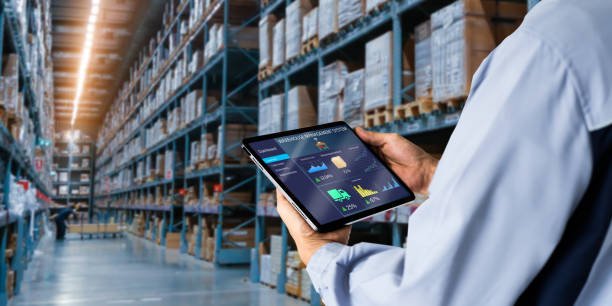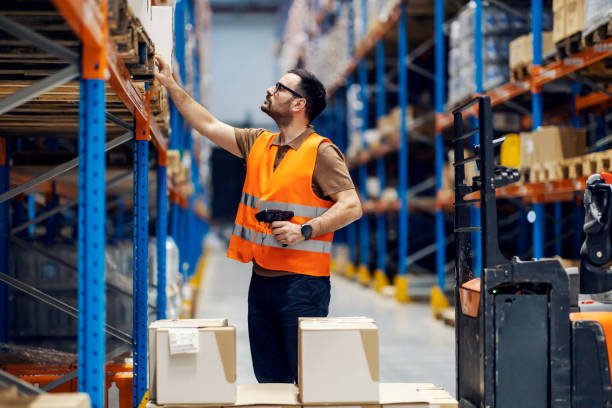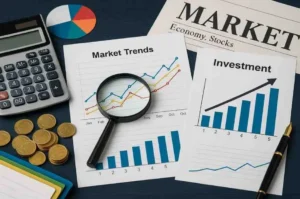Efficient distribution is essential for the success of businesses today. It plays a key role in the supply chain, ensuring that products move smoothly from manufacturers to consumers. This process involves managing transportation, warehousing, and inventory to meet market demands and keep goods flowing.
Distribution is not just about moving products; it directly impacts customer satisfaction and profitability. When products are delivered on time and reliably, customers are happier, which helps build loyalty. At the same time, efficient distribution reduces costs and boosts profits.
What is one way that technology can improve the distribution of goods? One way that technology can improve the distribution of goods is by optimizing route planning, and shipping packaging which helps ensure faster and more cost-effective deliveries
With technology playing an increasingly important role, businesses are focusing on improving their distribution processes to stay competitive in today’s fast-paced market.
Overview of How Technology Has Transformed Various Aspects of Distribution

Technology has revolutionized the distribution of goods in numerous ways, making processes faster, more efficient, and more reliable.
Advanced tools such as GPS and real-time tracking systems have significantly improved the accuracy and speed of deliveries by allowing companies to monitor the movement of goods in real time. Automation in warehouses or a packaging store, through the use of robotics and AI-driven systems, has streamlined inventory management and reduced human error, leading to quicker processing times and lower operational costs.
Additionally, the implementation of sophisticated data analytics has enabled companies to predict demand more accurately, optimize manufacturing of goods supply chain decisions, and better manage resources.
The Role Of Technology In Distribution Of Goods
In 2023, LMVH achieved 46% of its sales of selective distribution goods in the United States, indicating a significant market presence in North America compared to other regions.
1- Real-Time Inventory Tracking
The use of technology such as RFID (Radio-Frequency Identification) and IoT (Internet of Things) devices has transformed how companies track and manage their inventory. RFID tags, attached to products or packaging, allow for the automatic identification and tracking of goods as they move through the supply chain. IoT devices further enhance this process by providing real-time data on the location and condition of items.
Benefits:
- Reduced Inventory Errors: With RFID and IoT, manual entry errors are minimized, ensuring that inventory records are more accurate.
- Real-Time Visibility: Companies gain immediate insights into their inventory status, enabling them to monitor stock levels and movements in real time.
- Better Stock Management: Real-time tracking helps businesses optimize their inventory levels, reducing the risk of overstocking or stockouts and improving overall efficiency in stock management.
2- Automated Replenishment Systems
AI and machine learning algorithms have brought significant advancements in inventory management through automated replenishment systems. These technologies analyze historical sales data, seasonal trends, and other relevant factors to accurately predict demand for products. Based on these predictions, the system automatically triggers restocking orders, ensuring that inventory levels are maintained at optimal levels.
Benefits:
- Minimizes Stockouts: By predicting demand accurately, automated systems help ensure that products are restocked before they run out, reducing the risk of stockouts and lost sales.
- Prevents Overstocking: These systems also prevent overstocking by aligning inventory levels closely with anticipated demand, reducing excess inventory and associated carrying costs.
- Efficient Inventory Levels: Overall, automated replenishment systems enable businesses to maintain more efficient inventory levels, improving cash flow and reducing waste.
3- Route Optimization Software
Route optimization software leverages GPS technology and AI-driven algorithms to determine the most efficient delivery routes for transportation. This technology analyzes various factors such as traffic conditions, road closures, and delivery schedules to calculate the best routes for drivers.
Benefits:
- Reduced Fuel Costs: By finding the shortest and most efficient routes, companies can minimize fuel consumption, leading to lower operational costs.
- Faster Deliveries: Optimized routes enable quicker deliveries, enhancing customer satisfaction and improving overall service efficiency.
- Lower Carbon Footprint: Efficient route planning reduces the distance traveled and the associated emissions, contributing to a lower environmental impact and promoting sustainability.
4- Warehouse Management Systems (WMS)
Warehouse Management Systems (WMS) are software solutions designed to enhance the efficiency and effectiveness of warehouse operations. These systems optimize various aspects of warehouse management, packing, and shipping stores including layout planning, picking processes, and inventory tracking.
Benefits:
- Improved Accuracy: WMS ensures precise tracking of inventory and reduces errors in order picking and shipping, leading to fewer mistakes and returns.
- Faster Order Fulfillment: By streamlining picking processes and optimizing warehouse layout, WMS speeds up order processing and delivery times, improving overall customer satisfaction.
- Better Space Utilization: The system helps in organizing warehouse space more efficiently, maximizing storage capacity and reducing clutter, which contributes to a more organized and productive working environment.
5- Big Data and Analytics
Big Data and analytics involve the collection and analysis of large volumes of data from various distribution channels to gain insights and improve operations. This technology enables companies to track performance metrics, identify trends, and make informed decisions based on comprehensive data.
Benefits:
- Data-Driven Decision-Making: By analyzing data from multiple sources, companies can make informed decisions that are based on factual evidence rather than intuition.
- Enhanced Forecasting: Advanced analytics help in predicting future demand, sales trends, and supply chain issues more accurately, allowing for better planning and preparation.
- Better Resource Allocation: Insights gained from data analysis enable companies to allocate resources more effectively, optimizing inventory levels, staffing, and other operational aspects to improve overall efficiency.
6- Cloud-Based Platforms
Cloud-based platforms utilize cloud technology to facilitate real-time communication and collaboration across the entire supply chain. These platforms enable seamless access to data and tools from any location, enhancing connectivity between various stakeholders.
Benefits:
- Streamlined Information Flow: Cloud-based platforms centralize data, allowing for efficient and immediate sharing of information across the supply chain, which reduces delays and enhances coordination.
- Improved Collaboration: By providing a unified space for communication and document sharing, these platforms foster better collaboration among teams, suppliers, and partners.
- Quicker Decision-Making: Real-time access to up-to-date information supports faster and more informed decision-making, enabling companies to respond more swiftly to changes and challenges in the supply chain.
What Is One Way That Technology Can Improve The Distribution Of Goods?

One way that technology can improve the distribution of goods is by optimizing route planning through AI-driven software and GPS. This technology calculates the most efficient delivery routes, reducing fuel costs, speeding up delivery times, and lowering the carbon footprint.
Here’s how technology can improve the distribution of goods:
- Optimizes Route Planning: Uses AI-driven software and GPS technology.
- Reduces Fuel Costs: Calculates the most efficient routes to minimize fuel consumption.
- Speeds Up Delivery Times: Ensures quicker deliveries by finding the shortest paths.
- Lowers Carbon Footprint: Reduces emissions by minimizing travel distances.
Case Study of Amazon
Amazon exemplifies the use of technology to optimize its distribution network in several impactful ways:
- Advanced Robotics: Amazon employs robotics in its fulfillment centers to automate tasks such as sorting and picking. Robots work alongside human employees to increase efficiency and reduce the time it takes to process orders.
- AI and Machine Learning: Amazon uses AI algorithms to predict customer demand and manage inventory. This helps in stock replenishment and ensures that popular items are available when needed.
- Real-Time Tracking: The company offers real-time tracking for deliveries, providing customers with up-to-date information on their order status and estimated delivery times.
- Optimized Routing: Amazon’s delivery network uses sophisticated route optimization software to determine the most efficient delivery routes, reducing delivery times and costs.
- Prime Delivery Network: The integration of technology in Amazon Prime’s delivery network enables faster shipping options, including same-day and two-day delivery, by strategically positioning inventory closer to customers.
Case Study of Walmart
Walmart effectively utilizes technology to streamline inventory management and transportation, enhancing its supply chain efficiency:
- Retail Link System: Walmart’s proprietary Retail Link system provides real-time data on inventory levels and sales. This system allows suppliers to access up-to-date information and helps Walmart manage stock levels more effectively.
- RFID Technology: Walmart employs RFID (Radio-Frequency Identification) tags to track products throughout the supply chain. This technology improves accuracy in inventory management and reduces stock discrepancies.
- Cross-Docking: Walmart uses cross-docking at its distribution centers, where products are directly transferred from incoming trucks to outbound trucks with minimal storage time. This method reduces handling costs and speeds up the distribution process.
- Transportation Management System (TMS): Walmart’s TMS optimizes transportation routes and schedules, ensuring efficient and cost-effective deliveries. The system considers factors like traffic patterns and delivery windows to improve logistics.
- Data Analytics: Walmart leverages data analytics to forecast demand and optimize inventory levels across its vast network of stores and warehouses. This approach helps in maintaining a balanced stock and reducing out-of-stock situations.
How Technology Improves Various Aspects Of Distribution of Goods
Technology has significantly enhanced various aspects of distribution, leading to greater efficiency and effectiveness in supply chain management. Real-time inventory tracking through RFID and IoT devices provides accurate visibility of goods, reducing errors and improving stock management. Automated replenishment systems, powered by AI and machine learning, accurately predict demand and manage inventory levels, minimizing stockouts and overstocking.
Route optimization software utilizes GPS and AI to find the most efficient delivery paths, cutting fuel costs and delivery times while lowering the carbon footprint. Warehouse Management Systems (WMS) streamline operations by optimizing warehouse layout, picking processes, and space utilization, leading to faster order fulfillment and better accuracy.
Big Data and analytics enable data-driven decision-making, enhance forecasting, and improve resource allocation. Finally, cloud-based platforms facilitate real-time communication and collaboration across the supply chain, leading to more coordinated operations and quicker decision-making. Collectively, these technological advancements drive significant improvements in the speed, accuracy, and cost-effectiveness of distribution processes.











